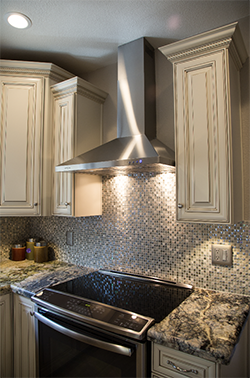https://old.rosieonthehouse.com/faqs/my-parents-are-getting-older-how-can-we-make-their-home-more-livable
My parents are getting older. How can we make their home more livable?
Here are some home renovations that will help make a home safer and more comfortable for people who might eventually need to use walkers or wheelchairs, suffer from arthritis or generally feel the aches and pains that inevitably accompany aging. This concept is often referred to as aging in place. For some, you might need to hire a contractor to do a little construction, but most of the others are do-it-yourself jobs: 
Big jobs
- Widen the hallways so a wheelchair or walker can pass through without bumping the walls. The optimal width is 42 inches.
- Likewise, widen the doorway to at least one of the home’s entrances and to the master bedroom and bathroom. You can have a contractor add two inches to your 30-inch doors, or you can add extension hinges that add two inches to the doorspan when the door is open.
- Reinforce the walls in the shower and next to the toilet so you can add grab bars if you want them.
- Redesign the first floor of the home so you can live on one level. Convert the guest room or an unused dining room into a first-floor master bedroom, and move the laundry room to the same level.
- Spring for extra-wide closets with pull-down racks so a wheelchair can fit in and a seated person can reach the clothes.
- Replace steps with a small ramp at one of the home’s entrances.
- Widen the first-floor bathroom to create a five-inch turn radius for a wheelchair.
- Convert your bathtub to a big shower with no curb to step over.
- Remove cabinets from under the bathroom sink so someone can sit down while using it.
Add-ons
- Add extra lighting in the kitchen and bathroom.
- Invest in a front-loading washing machine, and use a matching pedestal (available where you buy your appliances) to elevate your washer/dryer set by about 13 inches so you can load and unload without bending so far.
- Select a range and dishwasher with easy-to-reach controls on the front.
- When you’re ready to replace your refrigerator, buy a side-by-side model with the freezer on bottom so you can reach into the most-used area with ease.
- Check out the newest toilets. They come with washlets for personal hygiene and heated seats that automatically raise and lower. Look for one with a remote control.
- Even if you buy a “regular” toilet, find one that’s taller than usual. It’s easier to use a toilet that’s the same height as a chair—around 17 or 18 inches.
- Replace your hot-and-cold sink knobs with an easy-to-push lever handle.
Smart ideas
- When you replace your kitchen cabinets, place them four inches lower than average so a seated person can reach the dishes.
- Add a decorative white, laminate stripe around the edges of the cabinet to provide definition for someone with cataracts whose depth perception might be altered.
- Fashion a work area in the kitchen that’s the height of a desk and has an empty space underneath big enough for a chair to slide under it.
- Choose a floor in a matte finish, which is more slip resistant than a shiny floor and doesn’t reflect the light and create glare, which can disorient someone who has cataracts.
- Opt for mottled colors for floors and cabinets, and outline them with a lighter color so it’s easy to define where one stops and other begins.
- Add a bench and grab bars in the tub and shower.
###
Related Content
Blog Article: Remodeling Tips To Help You Age In Place | By TWD
DIY FAQ: How Do I Make Room For The Parents or Grandparents?
Podcast: Universal Design For Aging In Place (10:00 AM Segment)
